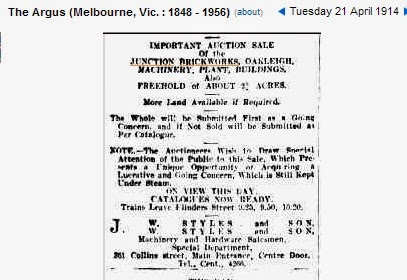Trading Name
|
Oakleigh Brick Company
also known as the
"Oakleigh Brick and Tile Company"
and the “Junction
Brick Company”
|
Years of
Operation
|
1909 to 1921
|
Company Number
|
C0000832T
|
Address
|
Ferntree Gully Road to the North, Dandenong Road to the
South and Tanner Street to the East.
|
Council Lot No.
|
|
Coordinates
|
-37.896937,
145.100598
|
Current Use
|
Public Open Space
(Hurst Park)
|
Also advertised in
the Sands and Macdougall Directory of 1911 and 1912 as the Junction Steam Brick
Co. (J.Hendy) Real High Grade Steam Bricks. Oakleigh; and 1915 as the Junction
Brick Co. Pty Ltd. Dandenong Rd. Oak. They appear to have had two
incarnations, one as a brick works and the second as a roofing tile maker.
This was another of the small,
short-lived companies in Oakleigh. They were located on that small
triangle of land now serving as parkland (Hurst Park) on the corner of
Dandenong and Fern Tree Gully Roads. Even though they called themselves a
company, there is no record of them registering as a company in Victoria.
A sole trader making bricks is not an easy life and there is no further mention
of this brick works.
This triangle of land was part of
the original Oakleigh East sub-division. On the 27th of March 1890 the
land was purchased by Clara Eliza Collins. Ida Segemeier inherited this
block when Clara died on the 29th of January 1902. Ida sold it almost
immediately to Ellen Matilda Green on the 17th of June 1902. She then
sold it to Joseph Murray, 3rd of March 1906.
This is where brick making enters
the picture. The block was sub-divided and sold to Frank Oliver Harford
on the 15th of June 1909, and the other block to John Hendy on the 24th of
November 1909. Both men were builders. John bought out Frank on the
24th of November 1909 and consolidated the blocks where they then began brick
making. This did not last long because the land was again sold, this time
to Frederick Oscar Bornum. Peter Finlayson and John Lemmon on the 2nd of June
1910, shortly after Frank and John's partnership dissolved.
They couldn't make a go of it
either and sold to Fritz Ernest Frankenberg on the 22nd of March 1912.
This is where the business went belly up with the plant and equipment
being sold off., ownership was also short-lived and Fritz sold to Richard
Arthur Ethell (another of Thomas's sons) the transfer happened on the 29th of
October 1914. The company is now listed in Sands and MacDougall under
"Tile Makers."
Richard later sold to Harold Frank Hunt on the 23rd of December 1919.
(Harold dropped off the perch a couple of years after he sold off the
works.)
This next bit is where it could
get confusing because Harold Hunt sold to the Terracotta Roofing Tile Company
on the 24th of March 1921. I suspect he saw a chance to offload what
these days would be seen as an under performing asset but Harold was also a
shareholder in the Terracotta Roofing Tile Company. I think Harold
probably did better out of the deal.
For some time after the Junction Brickworks closed, their boiler was kept lit
in the hope that the business would resume. It was not still going in
1921. This resumption of works did not happen and even when the
Terracotta Company took over, sales never matched production and the
site eventually lay idle, becoming a dangerous eyesore and health hazard.
They owned the land until the 18th of August 1939 when it was acquired by
Ernest Henry Montague Ratcliff (1863-1938). Ernest was also a Director of
the nearby Glen Iris Brick Company.
The property had lain idle since
the closure of the Terra Cotta Roofing Tile Company (see separate post) The
vacant site became a dumping ground and quickly became a health hazard.
Whatever plans Ernest may have had for the site, they never came to
fruition and the Council took legal action against Ernest to clean up the site.
The partnership of
J.Hendy, F.Harford and B.Rapley dissolved in 1910. It is noted that the
witness to this agreement was William Ethell.
According to the Oakleigh
Council records, in July 1927, Council decided they needed a new site for a
tip. Cr Andrews moved that a hole on
Dandenong Road be used, but Councilors threatened to resign if this was
done. In 1928 The East Oakleigh League wrote to the Council drawing
attention to the unsightly condition of the defunct tile works on the corner of
Dandenong and Fern Tree Gully Roads. They
suggested that Council purchase the property and make it into gardens. The
owners wanted £5,000. Council
said that they would pay only £2,500 for it
– but no money was available.

|
|
Junction Brick Works Site 1931
Aerial photograph courtesy of the Department of Environment and Primary Industries, Victoria
On the 17th of April 1929 the owners of the disused tile works at the corner of Dandenong and Fern Tree Gully Roads were given 14 days to erect a substantial fence around the clay hole. I don’t think that this referred to the corner site. If you look at the right of the picture, the remains of Scott’s pit can be seen encroaching onto Dandenong Road. There is a reference to this company being started by the Moroney Brothers but there appears to be no evidence of this. The carefully manicured parkland there now shows no sign of its former life.
|






No comments:
Post a Comment